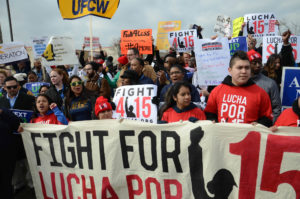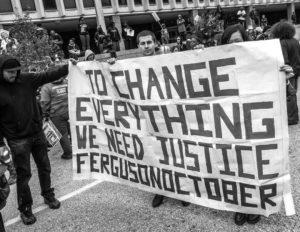The day after Thanksgiving is the busiest shopping day of the year in the United States. It’s known as Black Friday, a day retailers reduce prices to drive sales and kick off the holiday shopping season.
For the past three years, Black Friday has also been the focus of a movement aimed at improving working conditions for thousands of employees at the multibillion dollar retail giant, Walmart. In 2014, protests erupted nationwide after unarmed Black men were killed by police officers in Ferguson, Missouri, and New York City. Black Friday organizers and activists seized the momentum and combined their messages of economic and racial justice at thousands of Black Friday events.
These efforts demonstrate the increasing capacity of campaigners – and “regular people” – to build power by recruiting, mobilising and deeply empowering community members through collaboration, transparency and digital network building.
We spoke with activists and leaders from labor, union and other social advocacy organisations about efforts to bring their movements together around Black Friday.

Black Friday protesters in Bergen, New Jersey. Labor and union groups have been joined by Color of Change and others to call for better wages at WalMart.
Over 100 Organisations Join Black Friday Protests
OUR Walmart, a labor group comprised of current and former WalMart employees guides a growing network that includes civil and women’s rights groups, clergy and even some politicians. The latest actions emerged in some 1,600 stores nationwide. Workers rallied around calls for higher wages, more consistent work schedules, and an end to retaliation for speaking out against their employer. Before Black Friday, Walmart workers in a Los Angeles store staged a 24 hour fast, while stores in both Los Angeles and Washington, DC, witnessed historic sit ins.
Although actions started before Black Friday, the majority of Walmart workers went on strike on Wednesday, November 26th. Making Change at Walmart, which is anchored by the United Food and Commercial Workers (UFCW), is part of the broader coalition of groups that supports OUR Walmart. 230 organizations signed on to a letter to the Walton Family demanding Walmart pay their employees $15.00 an hour and provide full time jobs. Other calls include fair treatment for women, LGBT, and vets and to provide people of color equal representation among management.
“It’s mind blowing how many different groups we have here,” said Ed Lynch, Executive Assistant of UFCW Region 1. “UFCW is here, RWD [Retail, Wholesale and Department Store Union] is here, the teachers union is here, international president of AFT [American Federation of Teachers] is here, the postal workers are here as well as religious leaders and various activists.”
Connecting Communities and the Forces Affecting Them
WalMart is the largest private employer of Latinos, African Americans, and women in the United States. Many Walmart workers come from communities impacted by police brutality, leading protesters to merge messages of economic and racial justice.
At the Bergen, New Jersey, rally, protesters carried signs that read “hands up, don’t shop” and held a moment of silence for Michael Brown. “The struggle is not only for racial justice in Ferguson but also for economic justice,” said Sumumba Sobukwe, an organizer with Occupy Evolve, one of the last remaining groups from the Occupy Wall Street movement. He added, “whether you call it economic justice, racial justice, local justice, or social justice, all these issues are tied.”
At a newly opened Walmart Supercenter in Washington, DC, protesters took a detour from their Ferguson rally to march through the store chanting “Shut Walmart Down,” “No justice, no peace,” and “A living wage, no peace.” They also hoisted a banner above a Walmart customer service sign that read “Justice for Mike Brown! Jail Ofc Darren Wilson for Murder, Stop Racist Police Terror.”
Rashad Robinson, the executive director of Color of Change, thinks the two messages aren’t so different. “The labor and economic justice movement had its own civil rights movement” said Robinson. “The march for jobs is probably the most famous march this country has ever had…and when Dr. King was assassinated, he was with striking workers in Memphis.”
Color of Change has been an ally to Walmart workers throughout the years by orchestrating actions to support those fired by the company. The online civil rights organization engaged in calling out board members of Walmart, and they’ve participated in ongoing strategy calls and meetings.
The organization’s collaboration with Walmart strikers marked new territory according to Aimee Castenell, the campaign director for Color of Change. “Through our research we discovered that Walmart is the largest employer of Black people, Walmart exists in a lot of Black communities…and especially in 2012 when they were really pushing for [urban] expansion, we were starting to hear from people in local communities that they were worried that Walmart was coming in with jobs that were not secure and jobs that didn’t pay a living wage.”
Color of Change started an online petition calling on the company to pay their employees $15.00 an hour and in 2012, they drafted a letter to Rob Walton, chairman of the board of directors, asking him to meet with Walmart workers to discuss wages, scheduling and benefits. In 2013, organizers with Color of Change traveled with members of OUR Walmart and UFCW to Bentonville, Arkansas, home of Walmart headquarters, to participate in direct actions around the shareholder’s meeting.
Last year, because Color of Change was heavily involved in actions surrounding the unarmed death of Michael brown in Ferguson and the subsequent protests against police brutality, they were able to weave in their messaging with OUR Walmart into messaging surrounding “Black out Black Friday,” a Black Friday boycott.
“If we are saying that Black lives matter…we have to know that Black lives matter not just when you’re being harassed by police or not just when you’re walking outside on the street but it matters at your job, it matters everywhere…so Black lives matter is just as much of an economic justice message as it is a criminal justice message and that’s the point we were trying to come together on.”
Direct Support for Actions Both Online and on the Coasts
When OUR Walmart held their first Black Friday action in 2012, they received a huge outpouring of support from the community and other organizations, including many that reached out to Making Change at Walmart. Staff at Making Change at Walmart supplied packets of shareable online information including graphics, blog posts and sample emails. As the campaign to improve working conditions for Walmart workers has evolved, that support network now checks in every couple of weeks to receive updates from workers.
While any decisions to strike or take particular actions are ultimately up to members of OUR Walmart, Making Change at Walmart plays a supportive and advisory role, teaching tactics and ways to spread awareness across digital platforms. One effective method involved the use of The Action Network, a free online platform for small groups and individuals that markets itself as a nonprofit that only works with progressives. The site allows allies to collaborate on joint actions and Making Change at Walmart used it to work on petitions with other organizations as well as share data.
A distributed event tool also allowed Making Change at Walmart to post different store locations across the country on a map that organizers and allies could search to find protests in their area on Black Friday. Users could also request to hold their own protests and would gain access to materials like leaflets, protest signs and info about the legality of certain actions.
And to help provide training and feedback for supporters,“war rooms” were established on the East and West Coast. Staff from Making Change at Walmart, volunteers and community members served as a resource for those striking. A first time Walmart protester could contact the “war center” via email and a hotline. Those avenues of communication essentially served as a support network for those participating in actions.
Social Media Planning and Training Builds Partnerships
In the lead up to the sit down strikes at Walmart stores in Washington DC and Los Angeles, the first ever in the company’s history, organizers from Making Change at Walmart spoke to OUR Walmart members about effective strategies.
One organizer stressed the goal to answer questions like: Is this something we want to do? Does it make sense? Is there a better strategy? Perhaps, a better way to get a point across? Once the decision was made to hold the sit in (and voted on by members of OUR Walmart), Making Change at Walmart helped train strikers on social media by providing insight on live tweeting and photo opportunities. The hashtag #Walmartstrikers continued to trend for the third consecutive Black Friday, demonstrating a steady stream of interest in the movement.

Black Friday protesters carry a sign with the #Walmartstrikers hashtag outside a Bergen, New Jersey, Walmart. Photo by Agnes Radomski.
The digital component of the campaign doesn’t end with hashtags. The retail behemoth employs “more than 1.3 million people in more than 5,000 stores nationwide” according to their corporate website, making it a challenging endeavor to match in scale for such a young movement. But digital tools like Twitter and Facebook have allowed workers to connect and organically grow in size.
Two pages on Facebook, “OFFICIAL support Walmart Strikers on Black Friday” and “Walmart Free New York” have a combined number of 10,305 followers, but organizers with Making Change at Walmart say there are potentially hundreds of groups, both private and public that exist on Facebook. Group members vary, as some are a mix of supporters and Walmart workers while some are private groups that consist solely of Walmart workers. Other groups include Colorado Walmart workers, and Latino Walmart workers, a group that fits the demographic of who Walmart employs.
Changing How Walmart Does Business
Three years of Black Friday Walmart protests now have Robinson and other supporters taking notice of the fruits of their labor. Last October, the CEO of Walmart, Douglas McMillon, announced the company plans to pay all of its workers higher than the federal minimum wage of $7.25. And several months earlier, in March, Walmart announced a change in the company’s pregnancy policy, stating that “temporary disabilities caused by pregnancy are eligible for the same reasonable accommodations as other disabilities.”
Ed Lynch thinks the modest changes in Walmart policies are significant. “In a very small way, we’ve begun to change how Walmart does business,” he said.
Looking forward, whatever policy the growing coalition wants to take on or continue to push for, the decision ultimately lies to the workers. Barbara Gertz, a Walmart employee of six years, and an OUR Walmart member for two years, will remain at the forefront of whatever actions are taken at her Colorado store.
“They don’t treat me the way they used to,” she said. “They know I know my rights and I’ll hold them accountable.”
Top photo: Protesters gathered outside a WalMart in Bergen, New Jersey, on Black Friday in 2014. By Agnes Radomski.
Categories:
organising, mobilising and engagement




